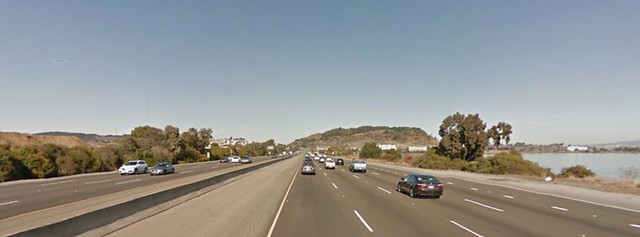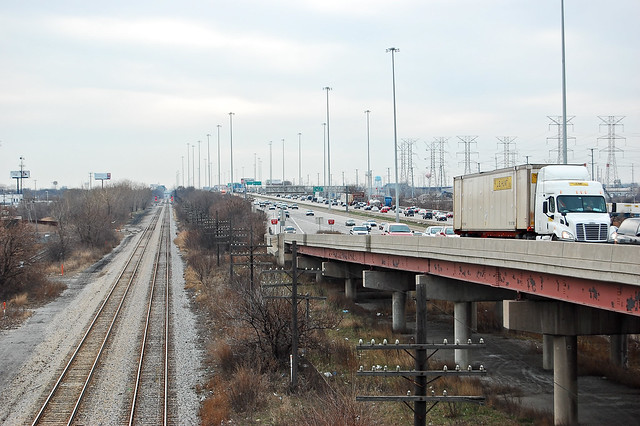
As Chicago transportation experts have pointed out, there are some positive aspects to Illinois Governor Bruce Rauner’s plan to use public-private partnership funding to widen 25 miles of the Stevenson Expressway, aka I-55, and then manage congestion on the new lanes via variable tolls. However, a much smarter approach to dealing with highway congestion may soon be pioneered in the Bay Area: Converting existing lanes to tolled lanes and using the revenue to fund transit. Illinois leaders would be wise to at least consider this strategy as an alternative to highway expansion.
If it’s inevitable that the Stevenson is going to be widened, it would be better for the estimated $425 million cost to be largely paid for by fees from users, rather than making all Illinois taxpayers foot the bill. And, while new lanes that aren’t tolled would likely just fill up with cars again due to induced demand, well calibrated congestion pricing would help ensure that traffic flows smoothly in the tolled lanes. Not only would solo drivers who pay the fee benefit from this, but Pace buses and carpoolers would likely be able to use the traffic-jam-free lanes at no cost.
However, as the Active Transportation Alliance has pointed out, there are some big drawbacks to the plan. Even though the new lanes will be managed, they still represent more capacity for single-occupant vehicles, which means more vehicle miles traveled, more pollution, and more traffic on surface roads leading to and from the Stevenson. In addition, making it easier to drive on the expressway will promote car-centric development patterns, which discourage walking, biking, and transit use.
There’s also an equity issue to building this kind of high-occupancy toll lane. Although the express lanes would encourage bus ridership and carpooling, they are also sometimes criticized as being a perk for wealthy people who choose to drive alone, and are thus nicknamed “Lexus Lanes.” And, with Rauner’s plan, since private investors would have to be paid back for financing the construction of the new lanes, the toll revenue would already be spoken for and couldn’t be used for other local transportation needs.

Meanwhile, California leaders are seriously considering a much more progressive proposal to convert existing lanes of a Bay Area highway to tolled lanes that prioritize buses and carpoolers, and use the revenue to fund transit. The campaign for these "Optimized HOT Lanes” on Highway 101 south of San Francisco was first proposed by TransForm, a regional advocacy group, in late 2013. This bold proposal is something that has never been done in the United States before.
In an interview posted last week by the TransitCenter foundation (a Streetsblog Chicago funder) TransForm staffers Jeff Hobson and Clarrissa Cabansagan discussed how a recent change in Caltrans’ (the state transportation department) attitude towards induced demand may help make this proposal a reality. While the state of Illinois hasn’t admitted that Rauner’s plan will result in more driving, new state of California guidelines acknowledge that induced demand is real: If you build more lanes, cars will come.
“Not only is the state [of California] saying that highway widening will increase driving, but that agencies should consider converting existing general purpose lanes to express lanes as mitigation,” Hobson said. “That’s huge in legitimizing TransForm’s proposal, and making it easier for agencies to consider conversions instead of widening in the future.”
TransForm’s audacious plan seems to have some real traction with decision makers. San Mateo County, which includes the peninsula south of San Francisco, worked with the local metropolitan planning organization on an analysis of the plan, which confirmed that the proposal would move more residents, more efficiently, while costing less than highway expansion.
The Bay Area plan is also more equitable than the I-55 proposal. Since the tolls from the Highway 101 express lanes wouldn’t have to be used to pay back lane construction costs, the fees paid by solo drivers could be used to improve transit. That way, the revenue would benefit transit riders of all income levels, and the increased transit use would also help make the non-tolled lanes a little less congested. As such, TransForm argues that, rather than Lexus Lanes, the plan would create "Robin Hood Lanes."
Granted, it might be harder to pull off such a forward-thinking plan in the Chicago region than in the politically progressive Bay Area. It’s also true that Highway 101 in San Mateo County generally has five lanes in each direction, while the Stevenson generally has three in each direction, which might make lane conversions a tougher sell. An IDOT staffer recently said that the idea of converting existing lanes on Chicago’s eight-lane-wide Lake Shore Drive to transit-only lanes is probably a non-starter.
But it would be great if Illinois leaders would at least study the possibility of converting existing lanes on I-55 as an alternative to building new ones, something Active Trans has proposed. If it was feasible to do so, converting lanes on the Stevenson would have the effect of reducing car dependency, rather than increasing it.



